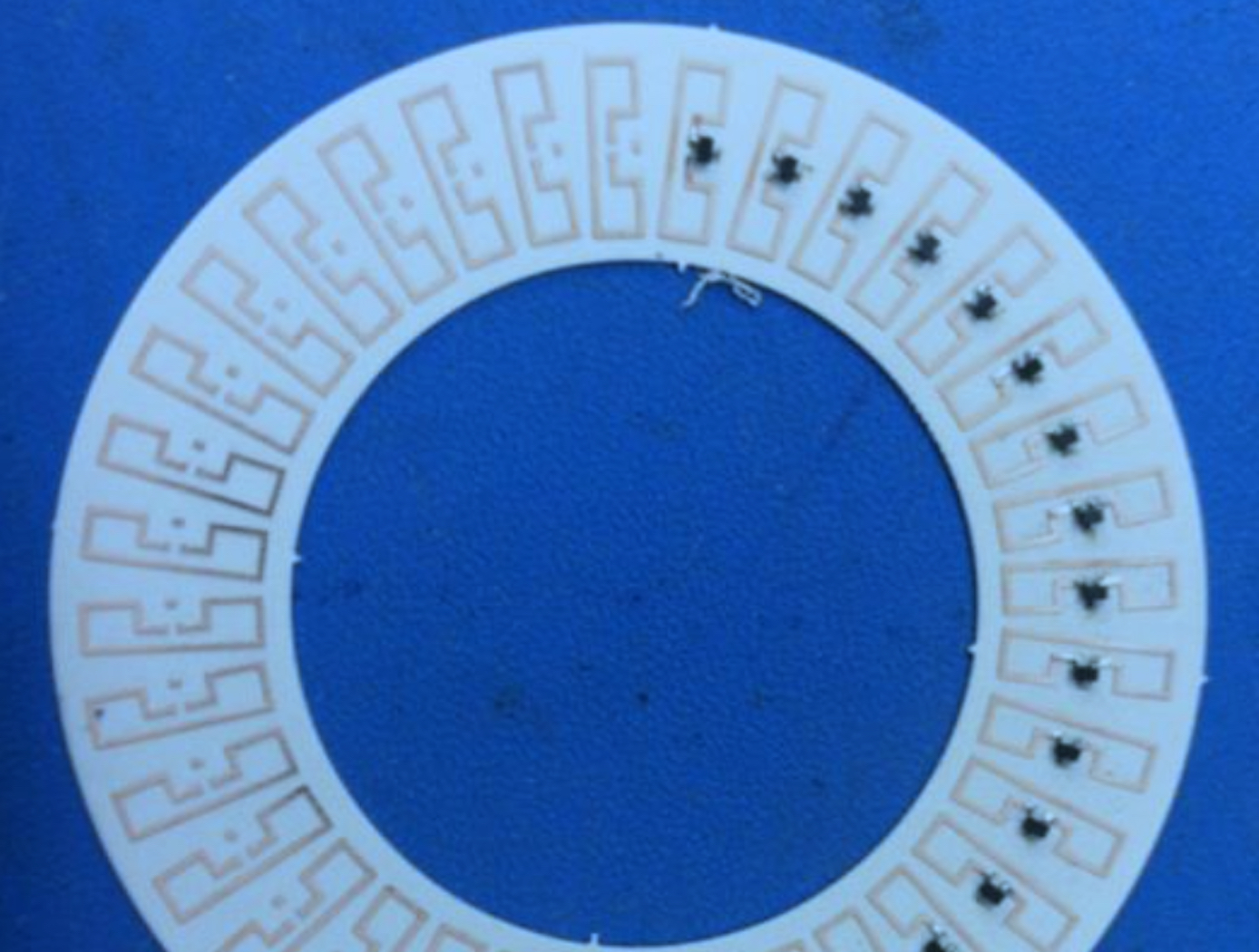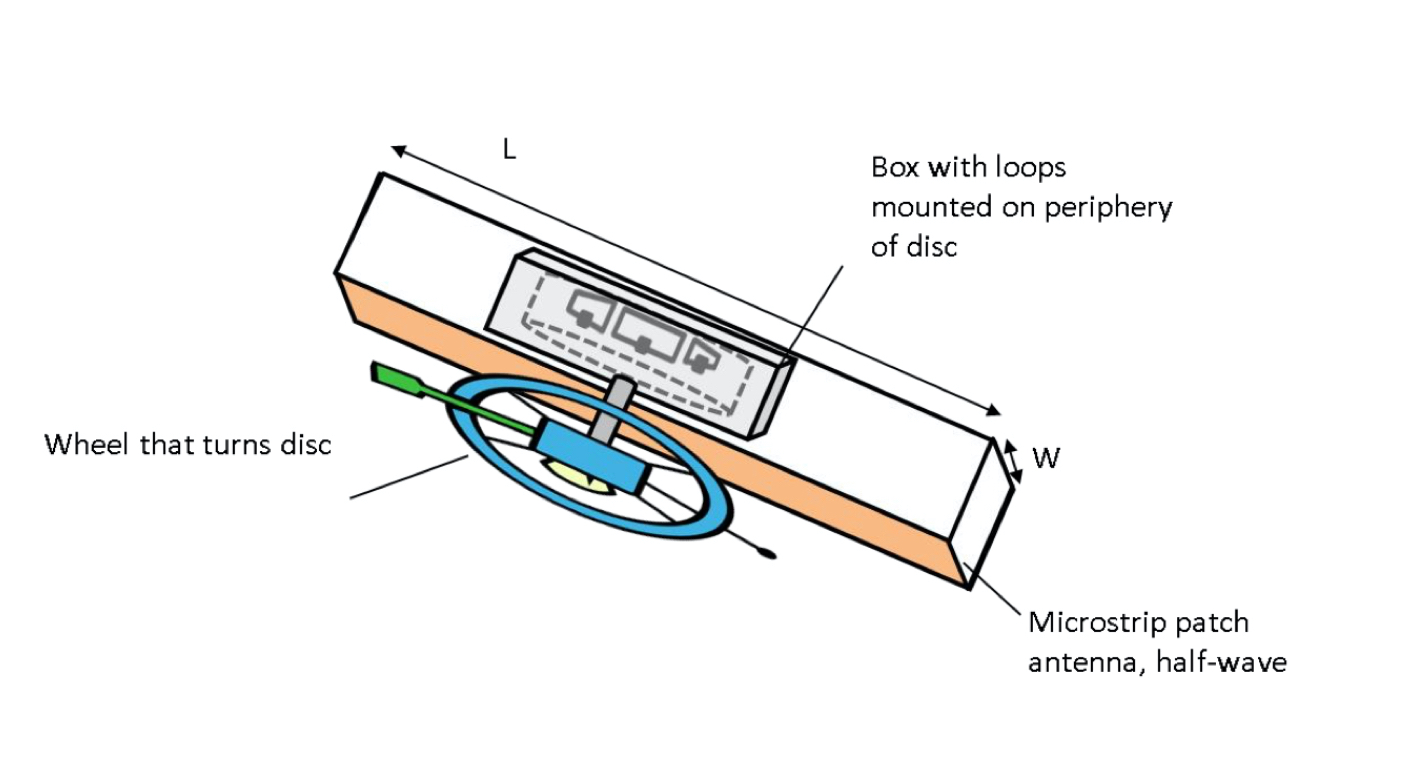RFID-Based Rotary Position Sensor
sensors
RFID-Based Rotary Position Sensor (MSC-TOPS-82)
For Sensing or Refining Angular Position of a Rotating System
Overview
Innovators at the NASA Johnson Space Center (JSC) have developed an RFID-based system for sensing the angular position of rotating systems. The RFID-Based Rotary Position Sensor can be used as a position/orientation sensor, or implemented in a controller to interpolate and refine the rotation angle of a rotating system. The RFID-Based Rotary Position Sensor is part of a suite of RFID-based technologies developed at NASA JSC to monitor and manage inventory based on passive RFID sensors. NASA's RFID sensors can wirelessly track either bulk levels or discrete quantities of materials within a container without having to attach RFID tags to each item. The RFID-Based Rotary Position Sensor was created as part of a hand-crank dispenser system in order to track items that were too small to tag individually, but the sensor can be used on a larger scale and in a variety of applications to sense or control angular position of rotating systems.
The Technology
The RFID-Based Rotary Position Sensor was designed for use in a hand-crank dispenser with a circular disc inside the dispenser box containing a plurality of RFID integrated circuits (ICs) around the disc's periphery. An antenna is coupled to the crank on the outside of the box, which allows a user to turn the disc and dispense items. An RFID interrogator, coupled to a processor, determines the orientation of the crank based on the RFID ICs, providing information about the rotation angle of the internal disc which can then be used to assess level of material remaining in the dispenser. This sensor can be useful for items that are too small to tag individually (e.g., pharmaceutical pills), but there are various potential applications for the sensor system including use in limit switches, position sensors, and orientation sensors. The configuration of the RFID ICs and antenna can be tailored for specific applications. For example, the system could be used in a rack-and-pinion gear system to measure the rotational or angular displacement that arises from a linear force. Furthermore, the system could be incorporated into a rotary controller to refine the rotation angle of a rotating system, like a steering systemor rotor, for example.
NASA's RFID-Based Rotary Position Sensor is at a TRL 6 (system/subsystem model or prototype demonstration in a relevant environment) when used in its original application as part of a hand-crank dispenser system. For additional applications that have not been explored by NASA, the invention is at a TRL 4 (component and/or breadboard validation in a laboratory environment).


Benefits
- Widely adaptable: The system can be tailored to specific applications for determining the position, or controlling, a rotating structure
- Uses standard, cost-effective components: The technology leverages common RFID integrated circuits and is compatible with the EPCglobal Class-1 Generation-2 RFID standard
- Offers power-free sensors: The RFID ICs are passive, which means the sensor does not require additional wired power or batteries
Applications
- Aerospace
- Automotive
- Consumer goods
- Industrial machinery
- Inventory management
- Logistics
- Medical devices
- Military
- Oil and gas
- Robotics
|
Tags:
|
Similar Results

Passive Smart Container
Passive Smart Container system comprises four major components: RFID circuits embedded in or around the container, an antenna and RF distribution system, and an interrogator/reader. The system uses passive RFID circuits placed on a bulk item container to track consumption and quantify items as the items are removed, added or replaced in the container. The antenna is strategically integrated with the lid or elsewhere in or around the container and is constantly coupling RFID signals to/from the RFID circuits. The circuits reply with information regarding the fill level in the container. A processor connected to the reader/interrogator can infer the fill level according to which RFID circuits respond and the magnitude and phase of the returned signals. The technology is compatible with the EPCglobal Class-1 Generation-2 RFID standard. This setup can be modified to track all kinds of items, large and small, making this technology suitable and applicable to an array of commercial fields.
RFID is a disruptive technology that has made a large impact on several industries, especially in supply chain and asset management. Passive Smart Container is well positioned to tap into this growing market. Its ability to account for discrete items as well as liquids and bulk goods that were deemed impossible or impractical to tag makes this technology relevant for an array of applications and industries.

Smart Enclosure using RFID for Inventory Tracking
The smart enclosure innovation employs traditional RFID cavities, resonators, and filters to provide standing electromagnetic waves within the enclosed volume in order to provide a pervasive field distribution of energy. A high level of read accuracy is achieved by using the contained electromagnetic field levels within the smart enclosure. With this method, more item level tags are successfully identified compared to approaches in which the items are radiated by an incident plane wave. The use of contained electromagnetic fields reduces the cost of the tag antenna; making it cost-effective to tag smaller items.
RFID-enabled conductive enclosures have been previously developed, but did not employ specific cavity-design techniques to optimize performance within the enclosure. Also, specific cavity feed approaches provide much better distribution of fields for higher read accuracy. This technology does not restrict the enclosure surface to rectangular or cylindrical shapes; other enclosure forms can also be used. For example, the technology has been demonstrated in textiles such as duffle bags and backpacks. Potential commercial applications include inventory tracking for containers such as waste receptacles, storage containers, and conveyor belts used in grocery checkout stations.

RFID Tag for Long Range and Wide Coverage Capabilities
The RFID Tag with Long Range and Wide Coverage Capabilities technology allows a RFID tag to direct a RFID reader beam signal back in the direction of arrival. This technology requires no added power to provide telemetry for long range readers by using multiple beams instead of one narrow beam signal. Each of the predetermined number of beams is typically associated with a unique identification number to derive bearing information. This innovation is suited for IC-based RFID tags as well as Surface Acoustics Wave (SAW) tags, which are useful for extreme environments.
The technology improves the ability to obtain telemetry (quantity, location, or sensor information) without GPS over a distant range. When the tag reports its identification, it also provides angular information to the source, which makes this technology useful for navigation and mapping applications. Because the technology provides an estimated angle between the signal antenna and the surface of each tag, the technology is able to triangulate the position of a mobile item identified with a RFID tag. The same innovation can be integrated to a RFID reader in order to enhance its range and distribute power to passive tags. The innovation has commercial applications in construction, oil and gas, seaport/harbor management, Internet of Things (IoT) and many more industries.

RFID Tags Collaborate for Data Retrieval
Commonly used RFID protocols are widely accepted because they are inexpensive and easy to implement. However, the associated low transmit power and narrow bandwidth typically result in coarse local-ization estimates. Often it is desirable to know the precise location of assets without reverting to an entirely different and more expensive protocol. Additionally, many industrial and other applications may desire technology that confirms the mating of components. This new program-mable sensor tag technology facilitates both precise localization and mating confirmation in-part by allowing the RFID sensor tag to become a type of distributed low-cost reader.
To determine a tag attachment, this innovation utilizes a fixed location RFID sensor tag that incorporates a receptacle node to measure an electrical “influence” through resistance, capacitance, inductance, etc. Assets for which localization is desired are outfitted with “influence tags” – devices that produce a set of distinguishable responses when placed in the receptacle region of the RFID sensor tag. Mating or connections are confirmed when electrodes from an influence tag become attached to matching electrodes on a sensor tag’s receptacle node. Information obtained by the RFID sensor tag is stored in its local memory bank through which a dedicated reader can retrieve influence tag information.
Potential applications exist for this technology where specific assets need to be precisely located and/or confirmation is needed when two parts have been correctly connected or attached. This RFID tag technology allows the retrieval of inventory status information in an energy efficient manner from inexpensive, small form factor hardware. Robotic retrieval of assets can be more easily facilitated with this innovation.

Pressure Sensor Mechanism
In operation, this RFID-enabled patented technology reacts to a pressure change causing the passive tag to generate an electromagnetic field. The RFID pressure sensor/passive tag reacts to the electromagnetic field and responds by sending a signal to an interrogator. The interrogator receives the reflected signal, measures the returned signal strength indications ("RSSI") of the reflected signal and sends the RSSI measurements and identification of the responding RFID sensors to the processor to determine the pressure. Potential applications for this technology include remote patient mobility monitoring, robotic control systems, and pressure sensing gloves. Older devices may also be outfitted with these sensors to add pressure-monitoring functionality while avoiding the cost of a total system replacement.



